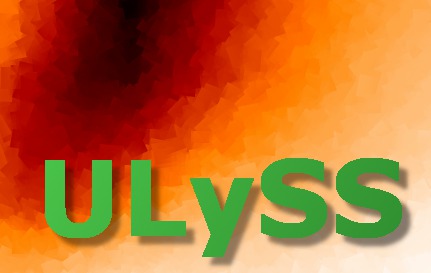
|

|
This page presents the basic usages of ULySS to fit a spectrum against
stellar templates, with a model of atmosphere or with stellar population
models.
The tutorials are written to follow a smooth progression, from commands
requiring minimal understanding of the method (ulyss, <my_spectrum>), to examples demonstrating the flexibility of the package
(make composite fits, set constraints on the parameters...).
GDL> star = uly_root+'/data/cflib_114642.fits'
GDL> ulyss, star
Use default model: Solar spectrum -------------------------------------------------------------------- INPUT PARAMETERS -------------------------------------------------------------------- The fits file to be analyze is ./data/cflib_114642.fits Name of the output file output.res Degree of multiplicative polynomial 10 No additive polynomial Component1 (cmp1) file:./models/sun.fits -------------------------------------------------------------------- -------------------------------------------------------------------- PARAMETERS PASSED TO ULY_FIT -------------------------------------------------------------------- Wavelength range used : 3464.9160 9469.5171 [Angstrom] Sampling in log wavelength : 20.079155 [km/s] Number of independent pixels in signal: 15011 Number of pixels fitted : 15011 DOF factor : 1.00000 -------------------------------------------------------------------- number of model evaluations: 35 time= 1.5249200 Number of pixels used for the fit 15007 cz : 7.5581444 +/- 0.96103474 km/s dispersion : 75.070373 +/- 0.88710896 km/s ----------------------------------------------- estimated SNR : 12.510639 ----------------------------------------------- cmp #0 cmp1 Weight : 0.0057345585 +/- 5.3433868e-05 [data_unit/cmp_unit] -----------------------------------------------
GDL> ulyss, star, MODEL_FILE=uly_root+'/models/elodie32_flux_tgm.fits', /PLOT
-------------------------------------------------------------------- INPUT PARAMETERS -------------------------------------------------------------------- The fits file to be analyze is ./data/cflib_114642.fits Name of the output file output.res Degree of multiplicative polynomial 10 No additive polynomial Component1 (cmp1) model:./models/elodie32_flux_tgm.fits Guess for Teff: 7000.0000 [K], Logg: 2.0000000 [cm/s2], Fe/H: 0.0000000 [dex] -------------------------------------------------------------------- -------------------------------------------------------------------- PARAMETERS PASSED TO ULY_FIT -------------------------------------------------------------------- Wavelength range used : 3900.2338 6800.1479 [Angstrom] Sampling in log wavelength : 20.079155 [km/s] Number of independent pixels in signal: 8300 Number of pixels fitted : 8300 DOF factor : 1.00000 -------------------------------------------------------------------- number of model evaluations: 68 time= 2.7778258 Number of pixels used for the fit 8218 cz : 1.3043659 +/- 0.14290816 km/s dispersion : 31.781528 +/- 0.15732457 km/s ----------------------------------------------- estimated SNR : 77.287751 ----------------------------------------------- cmp #0 cmp1 Weight : 0.99005952 +/- 0.010510920 [data_unit/cmp_unit] Teff : 6397.5471 +/- 4.0069625 K Logg : 4.0506557 +/- 0.0080833872 cm/s2 Fe/H : -0.15417556 +/- 0.0049592401 dex -----------------------------------------------
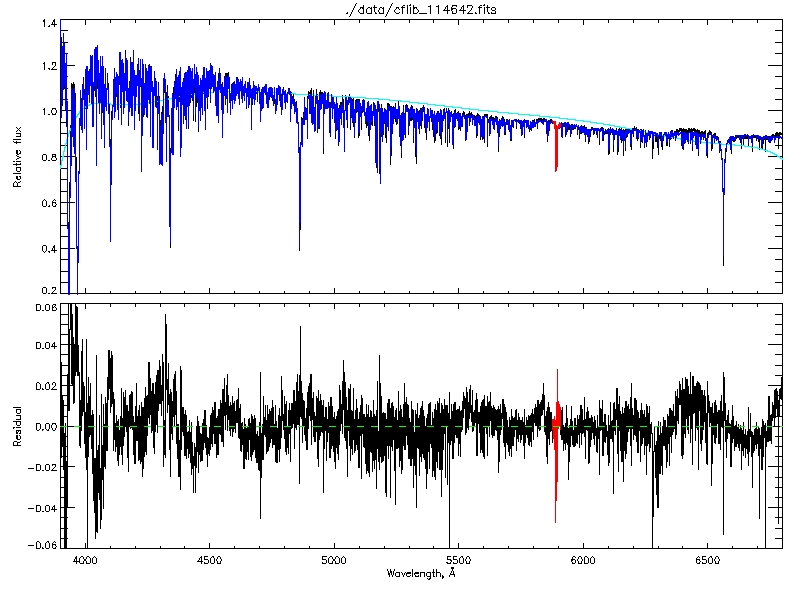
GDL> galaxy = uly_root+'/data/VazMiles_z-0.40t07.94.fits' GDL> ulyss, galaxy, MODEL_FILE= uly_root+'/models/PHR_Elodie31.fits'
-------------------------------------------------------------------- INPUT PARAMETERS -------------------------------------------------------------------- The fits file to be analyze is ./data/VazMiles_z-0.40t07.94.fits Name of the output file output.res Degree of multiplicative polynomial 10 No additive polynomial Component1 (cmp1) model:./models/PHR_Elodie31.fits Guess for age: 8000.0000 [Myr], Fe/H: -0.40000000 [dex] -------------------------------------------------------------------- Read the model ./models/PHR_Elodie31.fits read the file ./models/PHR_Elodie31.fits model reading time= 1.7968800 model deriving time= 0.21679497 -------------------------------------------------------------------- PARAMETERS PASSED TO ULY_FIT -------------------------------------------------------------------- Wavelength range used : 3900.5447 6800.7178 [Angstrom] Sampling in log wavelength : 51.501300 [km/s] Number of independent pixels in signal: 3236 Number of pixels fitted : 3236 DOF factor : 1.00000 -------------------------------------------------------------------- number of model evaluations: 52 time= 0.51620889 Number of pixels used for the fit 3172 cz : 6.4171465 +/- 0.29640537 km/s dispersion : 62.357711 +/- 0.30356847 km/s ----------------------------------------------- estimated SNR : 107.19732 ----------------------------------------------- cmp #0 cmp1 Weight : 1.0981672 +/- 6.8035115e-05 [data_unit/cmp_unit] age : 6355.5287 +/- 109.68133 Myr Fe/H : -0.36017315 +/- 0.0065616429 dex -----------------------------------------------
GDL> galaxy = uly_root+'/data/VazMiles_z-0.40t07.94.fits' GDL> spectrum = uly_spect_read(galaxy) GDL> specConv = uly_spect_losvdconvol(spectrum, 0., 30., 0, 0) GDL> uly_spect_free, spectrum GDL> ulyss, specConv, MODEL='models/PHR_Elodie31.fits', /QUIET, FILE_OUT='tuto_base'
GDL> uly_solut_tprint, 'tuto_base.res' GDL> uly_solut_splot, 'tuto_base.fits', WAVERANGE=[5000.,5200.]
cz : 6.3734618 +/- 0.37938520 km/s dispersion : 68.989962 +/- 0.38664303 km/s ----------------------------------------------- estimated SNR : 113.996 ----------------------------------------------- cmp #0 cmp4 Weight : 1.1169801 +/- 6.9208513e-05 [data_unit/cmp_unit] age : 6497.0194 +/- 130.65446 Myr Fe/H : -0.36589060 +/- 0.0074055300 dex -----------------------------------------------
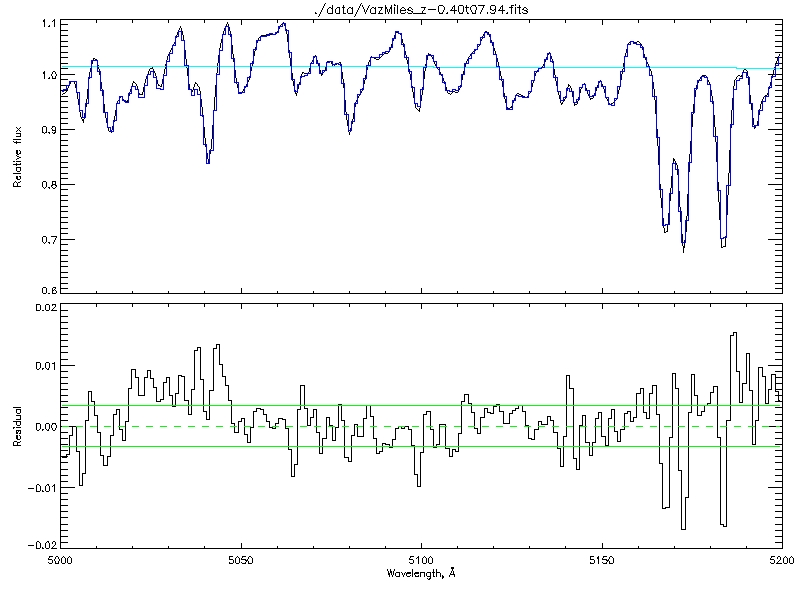
GDL> galaxy = uly_root+'/data/VazMiles_z-0.40t07.94.fits'
GDL> cmp1 = uly_ssp(AG=[1000.], ZG=[0], AL=[200.,3000.])
GDL> cmp2 = uly_ssp(AG=[10000.], ZG=[0], AL=[3000., 12000.])
GDL> cmp = [cmp1, cmp2]
GDL> ulyss, galaxy, cmp, /PLOT
-------------------------------------------------------------------- INPUT PARAMETERS -------------------------------------------------------------------- The fits file to be analyze is ./data/VazMiles_z-0.40t07.94.fits Name of the output file output.res Degree of multiplicative polynomial 10 No additive polynomial Component1 (cmp1) model:./models/PHR_Elodie31.fits Guess for age: 1000.0000 [Myr], Fe/H: 0.0000000 [dex] Component2 (cmp2) model:./models/PHR_Elodie31.fits Guess for age: 10000.000 [Myr], Fe/H: 0.0000000 [dex] -------------------------------------------------------------------- Read the model ./models/PHR_Elodie31.fits read the file ./models/PHR_Elodie31.fits model reading time= 1.7573318 model deriving time= 0.21527600 Read the model ./models/PHR_Elodie31.fits read the file ./models/PHR_Elodie31.fits model reading time= 1.7630351 model deriving time= 0.21560097 -------------------------------------------------------------------- PARAMETERS PASSED TO ULY_FIT -------------------------------------------------------------------- Wavelength range used : 3900.5447 6800.7178 [Angstrom] Sampling in log wavelength : 51.501300 [km/s] Number of independent pixels in signal: 3236 Number of pixels fitted : 3236 DOF factor : 1.00000 -------------------------------------------------------------------- number of model evaluations: 45 time= 0.73431396 Number of pixels used for the fit 3172 cz : 6.4343579 +/- 0.30888007 km/s dispersion : 62.408533 +/- 0.31547613 km/s ----------------------------------------------- estimated SNR : 104.62244 ----------------------------------------------- cmp #0 cmp1 Light fraction : 3.3730552 +/- 0.066524257 % Weight : 0.014335284 +/- 0.00028272413 [data_unit/cmp_unit] age : 2374.2576 +/- 77896.473 Myr Fe/H : -0.52676316 +/- 31.854347 dex ----------------------------------------------- cmp #1 cmp2 Light fraction : 96.626945 +/- 0.066056484 % Weight : 1.0035757 +/- 0.00068606830 [data_unit/cmp_unit] age : 5940.4404 +/- 206.11379 Myr Fe/H : -0.36143326 +/- 0.0083828031 dex -----------------------------------------------
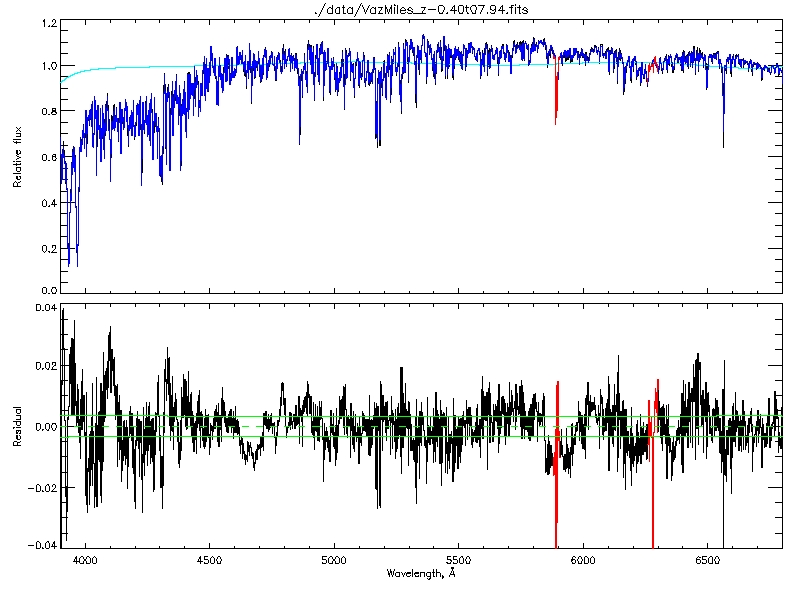
GDL> star = uly_root+'/data/cflib_114642.fits' GDL> model = uly_tgm_extr(star,[6400.,4.,0.]) ; Teff=6400K log(g)=4 [Fe/H]=0 GDL> cmp = uly_star(model) GDL> uly_lsf, star, cmp, 600, 300, FILE='tuto_lsf.txt', /QUIET GDL> plotsym,0,1,/FILL GDL> uly_lsf_plot, 'tuto_lsf.txt', YST=3, PSYM=8, CONNECT='Red'
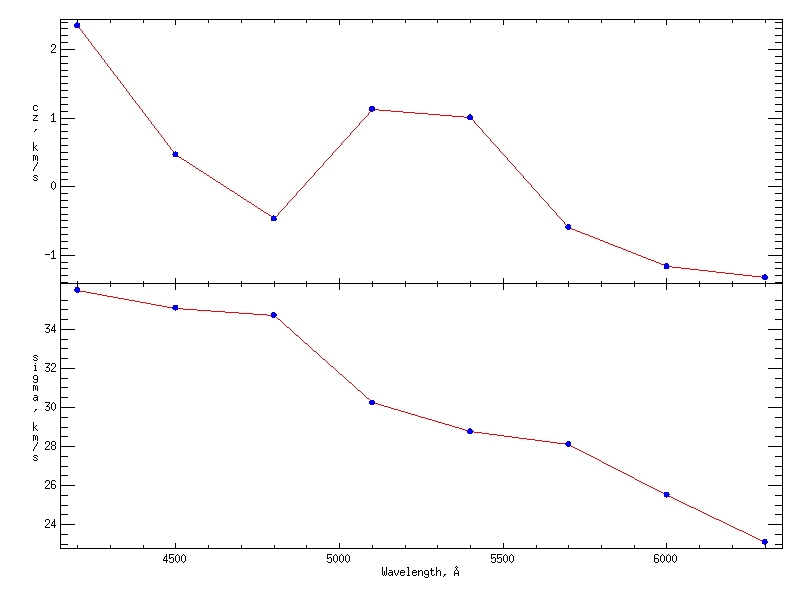
GDL> uly_lsf_smooth, 'tuto_lsf.txt', 'tuto_lsf_s.txt'
GDL> galaxy = uly_root+'/data/VazMiles_z-0.40t07.94.fits' GDL> cmp = uly_ssp(LSF='tuto_lsf_s.txt') GDL> ulyss, galaxy, cmp, /QUIET
| Contact: ulyss at obs.univ-lyon1.fr |
Last modified: Thu Jul 31 13:57:09 2008. |